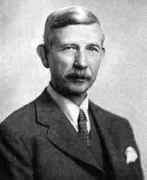◀ ▲ ▶History / 19th-century / Person: Wedderburn, Joseph Henry Maclagen
Person: Wedderburn, Joseph Henry Maclagen

Joseph Wedderburn worked for most of his life in Princeton. He made important advances in the theory of rings, algebras and matrix theory.
Mathematical Profile (Excerpt):
- Joseph was brought up in Forfar, north of Dundee, and he attended Forfar Academy from the age of five until he was thirteen.
- It was a time when Wedderburn made remarkable progress with his mathematics and in addition during 1902-03 he worked as an assistant in the Physical Laboratory of the University.
- Wedderburn then pursued postgraduate studies in Germany spending session 1903-1904 at the University of Leipzig and then the summer semester of 1904 at the University of Berlin.
- Already Wedderburn's mathematical interests were in algebra and his German trip allowed him to interact with Frobenius and Schur.
- The determination of finite division algebras was a very natural problem in the light of the work being undertaken in Chicago, and as soon as he arrived at Chicago, Wedderburn started to work on it, in close contact with Dickson.
- Returning to Scotland in 1905, Wedderburn worked for four years at the University of Edinburgh as an assistant to George Chrystal.
- The depth of Wedderburn's contribution to algebra during these years in Edinburgh was remarkable.
- This is in fact significant since Dickson also found a proof of this result but, since Wedderburn had already found his first "proof" (which Dickson believed to be correct), Dickson acknowledged Wedderburn's priority in a paper he wrote on the topic.
- Dickson noted in the paper that it is only after having seen his proof that Wedderburn constructed his second and third proofs.
- Wedderburn and Veblen showed that in all these geometries Pascal's theorem is a consequence of Desargues' theorem.
- In 1907 Wedderburn published what is perhaps his most famous paper on the classification of semisimple algebras.
- In 1909 Wedderburn returned to the United States being appointed a Preceptor in Mathematics at Princeton where he joined Veblen.
- Between 1905 and 1909 Eisenhart, Veblen, Bliss, George Birkhoff, and Wedderburn were appointed.
- Immediately Wedderburn volunteered for the British Army but, being an exceptionally modest man, he enlisted only in the role of private.
- From about the end of this period Wedderburn seemed to suffer a mild nervous breakdown and became an increasingly solitary figure.
- Ernst Snapper, who claimed to be only the fourth person ever with the courage to write a dissertation under Wedderburn (and one of the other three had lost his mind) told me this story explaining why Wedderburn was a bachelor.
- In Wedderburn's case his income had gone up so rapidly that he had never been able to accomplish this.
- Wedderburn made important advances in the theory of rings, algebras and matrix theory.
- The work is, however, not a compilation of the literature, but a synthesis that is Wedderburn's own.
- The important ideas of linear transformations, vector spaces, bilinear forms, though not set off, as is common in most modern treatments, do appear in Wedderburn's book.
- Among the honours which Wedderburn received were the MacDougall-Brisbane Gold Medal and Prize from the Royal Society of Edinburgh in 1921, and election to the Royal Society of London in 1933.
Born 2 February 1882, Forfar, Angus, Scotland. Died 9 October 1948, Princeton, New Jersey, USA.
View full biography at MacTutor
Tags relevant for this person:
Algebra, Origin Scotland
Thank you to the contributors under CC BY-SA 4.0! 

- Github:
-

- non-Github:
- @J-J-O'Connor
- @E-F-Robertson
References
Adapted from other CC BY-SA 4.0 Sources:
- O’Connor, John J; Robertson, Edmund F: MacTutor History of Mathematics Archive
